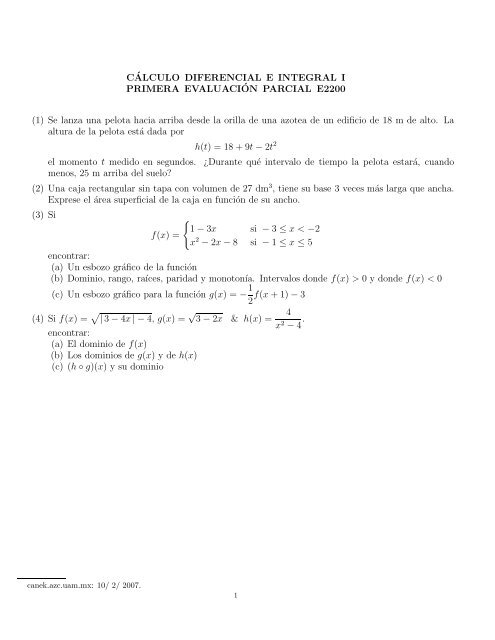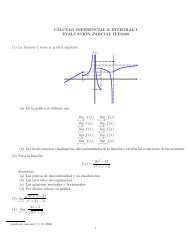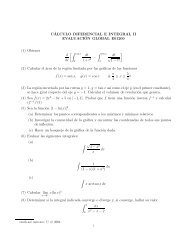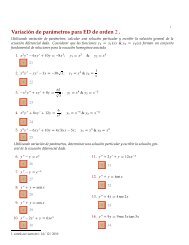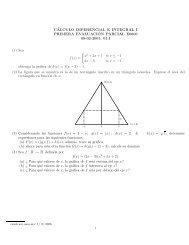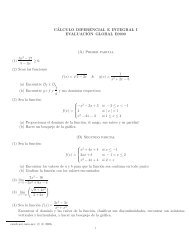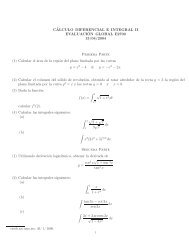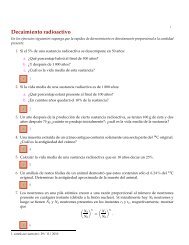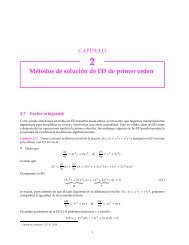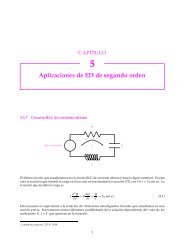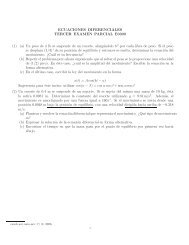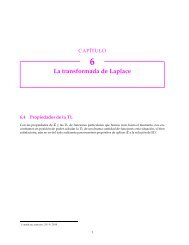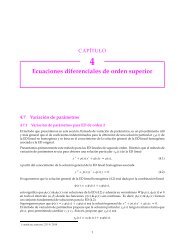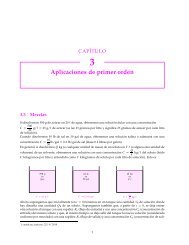Create successful ePaper yourself
Turn your PDF publications into a flip-book with our unique Google optimized e-Paper software.
CÁLCULO DIFERENCIAL E INTEGRAL I<br />
PRIMERA EVALUACIÓN PARCIAL <strong>E2200</strong><br />
(1) Se lanza una pelota hacia arriba desde la orilla de una azotea de un edificio de 18 m de alto. La<br />
altura de la pelota está dada por<br />
h(t) =18+9t−2t 2<br />
el momento t medido en segundos. ¿Durante qué intervalo de tiempo la pelota estará, cuando<br />
menos, 25 m arriba del suelo?<br />
(2) Una caja rectangular sin tapa con volumen de 27 dm3 , tiene su base 3 veces más larga que ancha.<br />
Exprese el área superficial de la caja en función de su ancho.<br />
(3) Si<br />
<br />
1 − 3x si − 3 ≤ x 0 y donde f(x) < 0<br />
(c) Un esbozo gráfico para la función g(x) =− 1<br />
f(x +1)−3 2<br />
(4) Si f(x) = | 3 − 4x |−4, g(x) = √ 3 − 2x & h(x) = 4<br />
x2 − 4 .<br />
encontrar:<br />
(a) El dominio de f(x)<br />
(b) Los dominios de g(x) ydeh(x)<br />
(c) (h ◦ g)(x) y su dominio<br />
canek.azc.uam.mx: 10/ 2/ 2007.<br />
1
2 PRIMERA EVALUACIÓN PARCIAL <strong>E2200</strong><br />
Respuestas<br />
(1) Se lanza una pelota hacia arriba desde la orilla de una azotea de un edificio de 18 m de alto. La<br />
altura de la pelota está dada por<br />
h(t) =18+9t − 2t 2<br />
el momento t medido en segundos. ¿Durante qué intervalo de tiempo la pelota estará, cuando<br />
menos, 25 m arriba del suelo?<br />
Resolver el problema es equivalente a resolver<br />
h(t) ≥ 25 ⇒ 18 + 9t − 2t 2 ≥ 25 ⇒−2t 2 +9t − 7 ≥ 0 ⇒ 2t 2 − 9t +7≤ 0 .<br />
Vamos a encontrar las raíces de la cuadrática 2t 2 − 9t +7=0<br />
Sabemos entonces que<br />
t = 9 ± √ 81 − 56<br />
4<br />
= 9 ± √ 25<br />
4<br />
= 9 ± 5<br />
4 =<br />
2t 2 − 9t +7=2 t − 7<br />
<br />
(t − 1) .<br />
2<br />
Para saber dónde la cuadrática es negativa usamos la tabla<br />
La solución es<br />
Intervalo t − 1<br />
Signo de<br />
t − 7<br />
2 (t − 7<br />
2<br />
t 1) 2 + + +<br />
•<br />
•<br />
1<br />
t ∈ 1, 7<br />
<br />
. 2<br />
•<br />
•<br />
7<br />
2<br />
7<br />
2<br />
1 .<br />
)(t − 1)<br />
(2) Una caja rectangular sin tapa con volumen de 27 dm 3 , tiene su base 3 veces más larga que ancha.<br />
Exprese el área superficial de la caja en función de su ancho.<br />
Usamos el siguiente dibujo.
PRIMERA EVALUACIÓN PARCIAL <strong>E2200</strong> 3<br />
(i)<br />
(ii)<br />
El volumen de la caja es<br />
El área lateral de la caja es<br />
h<br />
3x<br />
V =3x 2 h =27.<br />
AL =2× xh +2× 3xh =8xh.<br />
El área de la base de la caja es<br />
AB =3x 2 .<br />
Y ahora ya el área total:<br />
Despejamos h de (i)<br />
Sustituimos en (ii)<br />
Ésta es la expresión solicitada.<br />
AT = AB + AL =3x 2 +8xh.<br />
h = 27 9<br />
=<br />
3x2 x2. AT =3x 2 +8x 9<br />
x2 =3x2 + 72<br />
x .<br />
(3) Si<br />
<br />
f(x) =<br />
1 − 3x<br />
x<br />
si − 3 ≤ x
4 PRIMERA EVALUACIÓN PARCIAL <strong>E2200</strong><br />
vemos que tenemos una parábola con vértice (1, −9) y que se obtiene a partir de y = x 2<br />
desplazándola 1 unidad a la derecha y 9 unidades hacia abajo.<br />
Para obtener más información sobre la cuadrática calculamos los ceros o raíces:<br />
x = 2 ± √ 4+32<br />
2<br />
= 2 ± 6<br />
2 =<br />
Evaluamos la cuadrática en algunos puntos<br />
x x 2 − 2x − 8<br />
0 −8<br />
−1 −5<br />
5 7<br />
<br />
4<br />
−2 .<br />
Con la información anterior hacemos un esbozo de la gráfica<br />
A<br />
•<br />
B<br />
◦<br />
−3 −2<br />
f(x)<br />
10<br />
7<br />
−1 1<br />
C •<br />
−5<br />
• D<br />
−9 •<br />
E<br />
G •<br />
F<br />
•<br />
4 5<br />
<br />
(b) Dominio, rango, raíces, paridad y monotonía. Intervalos donde f(x) > 0 y donde f(x) < 0<br />
Dominio: Df =[−3, −2) [−1, 5].<br />
Rango: Rf =[−9, 10].<br />
Raíces: x =4.<br />
Paridad: la función no es par ni impar.<br />
La función decrece si x ∈ [−3, 2) y en [−1, 1].<br />
La función crece si x ∈ [1, 5].<br />
f(x) > 0six∈ [−3, −2) (4, 5].<br />
f(x) < 0six∈ [−1, 4).<br />
<br />
(c) Un esbozo gráfico para la función g(x) =− 1<br />
f(x +1)−3 2<br />
Cada valor de la nueva gráfica se obtiene de la anterior desplazándola una unidad a la<br />
izquierda, multiplicando el valor de la función por − 1<br />
y bajándola 3 unidades.<br />
2<br />
Vamos a obtener los valores de los puntos elegidos:<br />
Dg =[−4, −3) [−2, 4] .<br />
y los puntos x = −3, −2, −1, 0, 1, 4 y 5 se transforman respectivamente en<br />
x
PRIMERA EVALUACIÓN PARCIAL <strong>E2200</strong> 5<br />
x = −4, −3, −2, −1, 0, 3y4y:<br />
g(−4) = − 1<br />
2<br />
f(−4+1)− 3=−1<br />
2<br />
g(−3 − )=− 1<br />
2 f(−3− +1)− 3=− 1<br />
g(−2) = − 1<br />
2<br />
g(−1) = − 1<br />
2<br />
g(0) = − 1<br />
2<br />
g(3) = − 1<br />
2<br />
g(4) = − 1<br />
2<br />
f(−2+1)− 3=−1<br />
2<br />
f(−1+1)− 3=−1<br />
2<br />
f(0 + 1) − 3=−1<br />
2<br />
f(3 + 1) − 3=−1<br />
2<br />
f(4 + 1) − 3=−1<br />
2<br />
f(−3) − 3=−1 10 − 3=−5 − 3=−8;<br />
2<br />
2 f(−2− ) − 3=− 1<br />
2<br />
7 − 3=−13<br />
2 ;<br />
f(−1) − 3=−1 (−5) − 3=5 − 3=−1<br />
2 2 2 ;<br />
f(0) − 3=−1 (−8) − 3=4− 3=1;<br />
2<br />
f(1) − 3=−1 (−9) − 3=9 − 3=3<br />
2 2 2 ;<br />
f(4) − 3=−1 0 − 3=0− 3=−3;<br />
2<br />
f(5) − 3=−1 7 − 3=−7 − 3=−13<br />
2 2 2 .<br />
Por lo que los puntos A(−3, 10), B(−2, 7), C(−1, −5), D(0, −8), E(1, −9), F (4, 0), G(5, 7) se<br />
transforman también respectivamente en A ′ (−4, −8), B ′<br />
E ′<br />
<br />
0, 3<br />
2<br />
<br />
, F ′ (3, −3), G ′<br />
<br />
4, − 13<br />
2<br />
<br />
.<br />
<br />
−3, − 13<br />
2<br />
A(−3, 10) → (−4, 10) → (−4, −5) → A ′ (−4, −8);<br />
<br />
B(−2, 7) → (−3, 7) → −3, − 7<br />
<br />
→ B<br />
2<br />
′<br />
<br />
−3, − 13<br />
<br />
;<br />
2<br />
<br />
C(−1, −5) → (−2, −5) → −2, 5<br />
<br />
→ C<br />
2<br />
′<br />
<br />
−2, − 1<br />
<br />
;<br />
2<br />
D(0, −8) → (−1, −8) → (−1, 4) → D ′ (−1, 1);<br />
<br />
E(1, −9) → (0, −9) → 0, 9<br />
<br />
→ E<br />
2<br />
′<br />
<br />
0, 3<br />
<br />
;<br />
2<br />
F (4, 0) → (3, 0) → (3, 0) → F ′ (3, −3);<br />
<br />
G(5, 7) → (4, 7) → 4, − 7<br />
<br />
→ G<br />
2<br />
′<br />
<br />
4, − 13<br />
<br />
.<br />
2<br />
Con la información anterior, hacemos el esbozo de la gráfica:<br />
<br />
, C ′<br />
<br />
−2, − 1<br />
2<br />
<br />
, D ′ (−1, 1),
6 PRIMERA EVALUACIÓN PARCIAL <strong>E2200</strong><br />
−4<br />
A ′ •<br />
−3<br />
C ′<br />
•<br />
B ′<br />
◦<br />
−1<br />
−3<br />
f(x)<br />
2<br />
D ′<br />
E ′<br />
•<br />
•<br />
− 13<br />
2<br />
−8<br />
(4) <br />
(a) La función f(x) está definida siempre y cuando el radicando sea no negativo<br />
| 3 − 4x |−4 ≥ 0 ⇒ |3− 4x |≥4 .<br />
Esta última desigualdad es equivalente a las siguientes (que se cumplen simultáneamente)<br />
(i) 3 − 4x ≥ 4 ⇒ −1≥ 4x ⇒ − 1<br />
≥ x<br />
4<br />
o sea,<br />
<br />
x ∈ −∞, − 1<br />
<br />
.<br />
4<br />
(ii) 3 − 4x ≤−4 ⇒ 7 ≤ 4x ⇒ 7<br />
≤ x<br />
4<br />
o sea,<br />
<br />
7<br />
x ∈ , +∞ .<br />
4<br />
Por lo tanto,<br />
<br />
Df = −∞, − 1<br />
<br />
<br />
<br />
7<br />
, +∞ .<br />
4 4<br />
(b) De igual manera g(x) está definida si<br />
3 − 2x ≥ 0 ⇒ 3 ≥ 2x ⇒ 3<br />
≥ x ;<br />
2<br />
por lo tanto<br />
<br />
Dg = −∞, 3<br />
<br />
.<br />
2<br />
Se ve fácilmente que Dh = R −{−2, 2 } ya que x = −2 yx = 2 son los ceros de x2 − 4.<br />
(c) Calculamos:<br />
(h ◦ g)(x) =h[g(x)] = h √ 3 − 2x =<br />
x ∈ Dh◦g si cumple dos<br />
<br />
condiciones:<br />
(i) x ∈ Dg ⇒ x ∈ −∞, 3<br />
<br />
.<br />
2<br />
F ′<br />
•<br />
4<br />
( √ 3 − 2x) 2 − 4 =<br />
3 4<br />
G ′ •<br />
x<br />
4<br />
−1 − 2x<br />
= − 4<br />
2x +1 ;
PRIMERA EVALUACIÓN PARCIAL <strong>E2200</strong> 7<br />
(ii) y g(x) ∈ Dh ⇒ √ 3 − 2x ∈ R −{−2, 2}.<br />
Nos preguntamos para qué valores de x la raíz cuadrada es igual a −2 ya2.<br />
Nunca es igual a −2 ya que es no negativa.<br />
√ 1<br />
3 − 2x =2 ⇒ 3 − 2x =4 ⇒ −2x =1 ⇒ x = −<br />
2 .<br />
Tenemos entonces que<br />
<br />
Dh◦g = −∞, 3<br />
<br />
− −<br />
2<br />
1<br />
<br />
= −∞, −<br />
2<br />
1<br />
<br />
<br />
<br />
−<br />
2<br />
1<br />
<br />
3<br />
, .<br />
2 2


